Integrated Omics Analysis of Pathogenic Host Responses during Pandemic H1N1 Influenza Virus Infection: The Crucial Role of Lipid Metabolism
- PMID: 26867183
- PMCID: PMC5271177
- DOI: 10.1016/j.chom.2016.01.002
Integrated Omics Analysis of Pathogenic Host Responses during Pandemic H1N1 Influenza Virus Infection: The Crucial Role of Lipid Metabolism
Abstract
Pandemic influenza viruses modulate proinflammatory responses that can lead to immunopathogenesis. We present an extensive and systematic profiling of lipids, metabolites, and proteins in respiratory compartments of ferrets infected with either 1918 or 2009 human pandemic H1N1 influenza viruses. Integrative analysis of high-throughput omics data with virologic and histopathologic data uncovered relationships between host responses and phenotypic outcomes of viral infection. Proinflammatory lipid precursors in the trachea following 1918 infection correlated with severe tracheal lesions. Using an algorithm to infer cell quantity changes from gene expression data, we found enrichment of distinct T cell subpopulations in the trachea. There was also a predicted increase in inflammatory monocytes in the lung of 1918 virus-infected animals that was sustained throughout infection. This study presents a unique resource to the influenza research community and demonstrates the utility of an integrative systems approach for characterization of lipid metabolism alterations underlying respiratory responses to viruses.
Copyright © 2016 Elsevier Inc. All rights reserved.
Figures
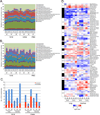
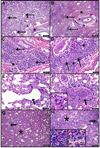
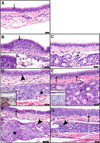
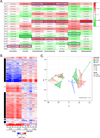
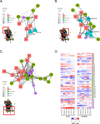
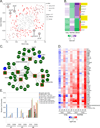

Similar articles
-
Pandemic H1N1 influenza virus causes a stronger inflammatory response than seasonal H1N1 influenza virus in ferrets.Arch Virol. 2011 May;156(5):759-67. doi: 10.1007/s00705-010-0914-7. Epub 2011 Jan 15. Arch Virol. 2011. PMID: 21234768
-
Pulmonary pathology of pandemic influenza A/H1N1 virus (2009)-infected ferrets upon longitudinal evaluation by computed tomography.J Gen Virol. 2011 Aug;92(Pt 8):1854-1858. doi: 10.1099/vir.0.032805-0. Epub 2011 May 4. J Gen Virol. 2011. PMID: 21543558 Free PMC article.
-
Clinical response to pandemic H1N1 influenza virus from a fatal and mild case in ferrets.Virol J. 2015 Mar 26;12:48. doi: 10.1186/s12985-015-0272-x. Virol J. 2015. PMID: 25888921 Free PMC article.
-
Comparison of the pathology caused by H1N1, H5N1, and H3N2 influenza viruses.Arch Med Res. 2009 Nov;40(8):655-61. doi: 10.1016/j.arcmed.2009.10.001. Epub 2010 Jan 6. Arch Med Res. 2009. PMID: 20304252 Review.
-
Metabolic host response and therapeutic approaches to influenza infection.Cell Mol Biol Lett. 2020 Mar 5;25:15. doi: 10.1186/s11658-020-00211-2. eCollection 2020. Cell Mol Biol Lett. 2020. PMID: 32161622 Free PMC article. Review.
Cited by
-
Simultaneous profiling and quantification of 25 eicosanoids in human serum by ultrahigh-performance liquid chromatography coupled to tandem mass spectrometry.Anal Bioanal Chem. 2022 Dec;414(29-30):8233-8244. doi: 10.1007/s00216-022-04351-6. Epub 2022 Nov 8. Anal Bioanal Chem. 2022. PMID: 36344666 Free PMC article.
-
The MPLEx Protocol for Multi-omic Analyses of Soil Samples.J Vis Exp. 2018 May 30;(135):57343. doi: 10.3791/57343. J Vis Exp. 2018. PMID: 29912205 Free PMC article.
-
Bacterial factors required for Streptococcus pneumoniae coinfection with influenza A virus.J Biomed Sci. 2021 Aug 27;28(1):60. doi: 10.1186/s12929-021-00756-0. J Biomed Sci. 2021. PMID: 34452635 Free PMC article.
-
The Role of EGFR in Influenza Pathogenicity: Multiple Network-Based Approaches to Identify a Key Regulator of Non-lethal Infections.Front Cell Dev Biol. 2019 Sep 20;7:200. doi: 10.3389/fcell.2019.00200. eCollection 2019. Front Cell Dev Biol. 2019. PMID: 31616667 Free PMC article.
-
Acute experimental infection of bats and ferrets with Hendra virus: Insights into the early host response of the reservoir host and susceptible model species.PLoS Pathog. 2020 Mar 30;16(3):e1008412. doi: 10.1371/journal.ppat.1008412. eCollection 2020 Mar. PLoS Pathog. 2020. PMID: 32226041 Free PMC article.
References
-
- Coulombe F, Jaworska J, Verway M, Tzelepis F, Massoud A, Gillard J, Wong G, Kobinger G, Xing Z, Couture C, et al. Targeted prostaglandin E2 inhibition enhances antiviral immunity through induction of type I interferon and apoptosis in macrophages. Immunity. 2014;40:554–568. - PubMed
Publication types
MeSH terms
Substances
Grants and funding
- P41 GM103493/GM/NIGMS NIH HHS/United States
- P51OD010425/OD/NIH HHS/United States
- U19 AI109761/AI/NIAID NIH HHS/United States
- P51 OD010425/OD/NIH HHS/United States
- HHSN272201400005C/PHS HHS/United States
- HHSN272201400006C/AI/NIAID NIH HHS/United States
- HHSN272200800060C/AI/NIAID NIH HHS/United States
- U19AI109761/AI/NIAID NIH HHS/United States
- T32 OD010423/OD/NIH HHS/United States
- HHSN272201400005C/AI/NIAID NIH HHS/United States
- 5T32OD010423-07/OD/NIH HHS/United States
- HHSN272201400006C/PHS HHS/United States
LinkOut - more resources
Full Text Sources
Other Literature Sources
Medical

